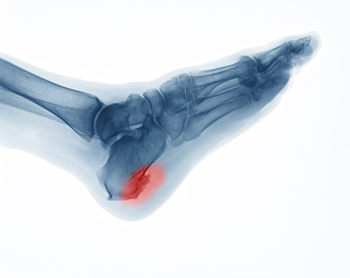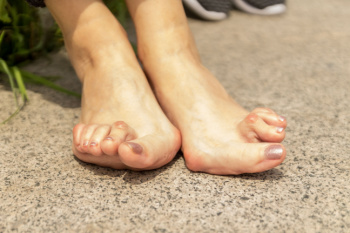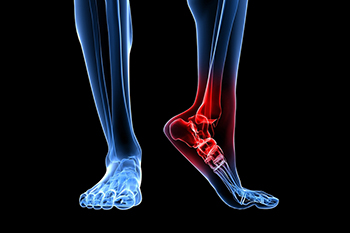Items filtered by date: May 2024
When Surgery Is Needed for Heel Spurs

When conservative treatments prove ineffective in easing the discomfort, inflammation, and swelling associated with heel spurs, surgery emerges as a viable solution. These outgrowths on the heel bone, medically termed calcaneal spurs, can cause significant pain and impede mobility. The decision to pursue surgery hinges not solely on the size or presence of the spur, but rather on the persistence of pain resistant to treatment. Podiatrists typically advocate for surgery when symptoms persist despite six months of non-surgical interventions. Two primary approaches exist for heel spur surgery, which are known as open surgery and endoscopic surgery. Open surgery entails larger incisions and is generally employed to excise entire spurs. Endoscopic surgery employs smaller incisions, fostering quicker recovery and fewer complications. The surgical procedure may vary depending on the spur's location, whether it is inferior or posterior. Inferior heel spurs often coexist with plantar fasciitis and are addressed through plantar fasciotomy. Posterior heel spurs near the Achilles tendon may necessitate more intricate procedures, especially if the spur is deeply embedded within the Achilles tendon. While heel spur surgery has a high success rate, it also carries risks of nerve injury, foot instability, and acquired flat feet. If you are in pain from a heel spur, it is suggested that you consult a podiatrist who can determine what the best course of treatment is for you.
Heel spurs can be incredibly painful and sometimes may make you unable to participate in physical activities. To get medical care for your heel spurs, contact James P. Huish, DPM from Arizona. Our doctors will do everything possible to treat your condition.
Heels Spurs
Heel spurs are formed by calcium deposits on the back of the foot where the heel is. This can also be caused by small fragments of bone breaking off one section of the foot, attaching onto the back of the foot. Heel spurs can also be bone growth on the back of the foot and may grow in the direction of the arch of the foot.
Older individuals usually suffer from heel spurs and pain sometimes intensifies with age. One of the main condition's spurs are related to is plantar fasciitis.
Pain
The pain associated with spurs is often because of weight placed on the feet. When someone is walking, their entire weight is concentrated on the feet. Bone spurs then have the tendency to affect other bones and tissues around the foot. As the pain continues, the feet will become tender and sensitive over time.
Treatments
There are many ways to treat heel spurs. If one is suffering from heel spurs in conjunction with pain, there are several methods for healing. Medication, surgery, and herbal care are some options.
If you have any questions feel free to contact our office located in Safford and Sierra Vista, AZ . We offer the latest in diagnostic and treatment technology to meet your needs.
Rheumatoid Arthritis and Foot Health
 Rheumatoid arthritis, or RA, is an autoimmune disease that causes inflammation in the joints. In RA, the immune system mistakenly attacks the lining of the joints, causing swelling, pain, and potentially severe joint damage. This can cause problems in any of the 30 foot joints, but it most commonly affects the toes and ankles. RA can also lead to deformities such as bunions, claw toes, or severe flattening of the foot, as well as pain and difficulty walking. Chronic inflammation can weaken the ligaments and tendons in the foot, leading to instability and increased risk of injury. Podiatrists, or foot doctors, can help manage RA-related foot issues by providing targeted treatments. Among them are orthotics to support the joints, advice on proper footwear to reduce stress on the affected areas, and exercises to maintain joint function and mobility. They also monitor for changes or deterioration in foot health that might require more aggressive interventions, including injections or surgery. If you’re a rheumatoid arthritis patient with problems in the feet and ankles, it is suggested that you add a podiatrist to your care team.
Rheumatoid arthritis, or RA, is an autoimmune disease that causes inflammation in the joints. In RA, the immune system mistakenly attacks the lining of the joints, causing swelling, pain, and potentially severe joint damage. This can cause problems in any of the 30 foot joints, but it most commonly affects the toes and ankles. RA can also lead to deformities such as bunions, claw toes, or severe flattening of the foot, as well as pain and difficulty walking. Chronic inflammation can weaken the ligaments and tendons in the foot, leading to instability and increased risk of injury. Podiatrists, or foot doctors, can help manage RA-related foot issues by providing targeted treatments. Among them are orthotics to support the joints, advice on proper footwear to reduce stress on the affected areas, and exercises to maintain joint function and mobility. They also monitor for changes or deterioration in foot health that might require more aggressive interventions, including injections or surgery. If you’re a rheumatoid arthritis patient with problems in the feet and ankles, it is suggested that you add a podiatrist to your care team.
Because RA affects more than just your joints, including the joints in your feet and ankles, it is important to seek early diagnosis from your podiatrist if you feel like the pain in your feet might be caused by RA. For more information, contact James P. Huish, DPM of Arizona. Our doctors will assist you with all of your podiatric concerns.
What Is Rheumatoid Arthritis?
Rheumatoid Arthritis (RA) is an autoimmune disorder in which the body’s own immune system attacks the membranes surrounding the joints. Inflammation of the lining and eventually the destruction of the joint’s cartilage and bone occur, causing severe pain and immobility.
Rheumatoid Arthritis of the Feet
Although RA usually attacks multiple bones and joints throughout the entire body, almost 90 percent of cases result in pain in the foot or ankle area.
Symptoms
- Swelling and pain in the feet
- Stiffness in the feet
- Pain on the ball or sole of feet
- Joint shift and deformation
Diagnosis
Quick diagnosis of RA in the feet is important so that the podiatrist can treat the area effectively. Your doctor will ask you about your medical history, occupation, and lifestyle to determine the origin of the condition. Rheumatoid Factor tests help to determine if someone is affected by the disease.
If you have any questions please feel free to contact our office located in Safford and Sierra Vista, AZ . We offer the newest diagnostic and treatment technologies for all your foot and ankle needs.
Essential Insights to Know about Gout

Gout, often termed the disease of kings, is a form of inflammatory arthritis caused by the accumulation of uric acid crystals in the joints, leading to intense pain and swelling. Contrary to popular belief, gout can affect anyone, regardless of social status or dietary habits. The condition typically manifests in sudden, severe attacks, commonly affecting the big toe. Factors contributing to gout include genetics, a diet rich in purines that are found in red meat, seafood, and alcohol, obesity, and certain medical conditions like hypertension or kidney disease. Despite its historical association with indulgence, gout is a legitimate medical concern that requires proper management and treatment. Without intervention, recurrent gout attacks can lead to joint damage and chronic pain, significantly impacting one's quality of life. If you have severe pain in your big toe and surrounding areas, it is strongly suggested that you seek advice from a podiatrist who can help you find relief and management methods.
Gout is a painful condition that can be treated. If you are seeking treatment, contact James P. Huish, DPM from Arizona. Our doctors will treat your foot and ankle needs.
What Is Gout?
Gout is a form of arthritis that is characterized by sudden, severe attacks of pain, redness, and tenderness in the joints. The condition usually affects the joint at the base of the big toe. A gout attack can occur at any random time, such as the middle of the night while you are asleep.
Symptoms
- Intense Joint Pain - Usually around the large joint of your big toe, and it most severe within the first four to twelve hours
- Lingering Discomfort - Joint discomfort may last from a few days to a few weeks
- Inflammation and Redness -Affected joints may become swollen, tender, warm and red
- Limited Range of Motion - May experience a decrease in joint mobility
Risk Factors
- Genetics - If family members have gout, you’re more likely to have it
- Medications - Diuretic medications can raise uric acid levels
- Gender/Age - Gout is more common in men until the age of 60. It is believed that estrogen protects women until that point
- Diet - Eating red meat and shellfish increases your risk
- Alcohol - Having more than two alcoholic drinks per day increases your risk
- Obesity - Obese people are at a higher risk for gout
Prior to visiting your podiatrist to receive treatment for gout, there are a few things you should do beforehand. If you have gout you should write down your symptoms--including when they started and how often you experience them, important medical information you may have, and any questions you may have. Writing down these three things will help your podiatrist in assessing your specific situation so that he or she may provide the best route of treatment for you.
If you have any questions, please feel free to contact our office located in Safford and Sierra Vista, AZ . We offer the newest diagnostic and treatment technologies for all your foot care needs.
Causes of Broken Heels

Understanding the causes of a broken heel helps in recognizing the signs and seeking appropriate treatment. Fractures in the heel often result from significant force, such as falling from a height, a car accident, or a sports injury. Repetitive stress on the heel, which may develop from long-distance running, can lead to stress fractures in the heel. Symptoms of heel fractures include pain when touching and putting weight on it. Swelling and difficulty walking normally are other symptoms. A fracture of the heel bone may also cause internal bleeding, resulting in bruising after a day or so. To diagnose a broken heel, a podiatrist employs X-rays and sometimes CT scans. Treatment may involve wearing a cast or splint. Surgical intervention for severe cases and the use of assistive devices like canes and protective footwear during recovery may be prescribed. If you suspect a broken heel, it's suggested that you make an appointment with a podiatrist for proper evaluation and personalized care.
A broken foot requires immediate medical attention and treatment. If you need your feet checked, contact James P. Huish, DPM from Arizona. Our doctors can provide the care you need to keep you pain-free and on your feet.
Broken Foot Causes, Symptoms, and Treatment
A broken foot is caused by one of the bones in the foot typically breaking when bended, crushed, or stretched beyond its natural capabilities. Usually the location of the fracture indicates how the break occurred, whether it was through an object, fall, or any other type of injury.
Common Symptoms of Broken Feet:
- Bruising
- Pain
- Redness
- Swelling
- Blue in color
- Numbness
- Cold
- Misshapen
- Cuts
- Deformities
Those that suspect they have a broken foot shoot seek urgent medical attention where a medical professional could diagnose the severity.
Treatment for broken bones varies depending on the cause, severity and location. Some will require the use of splints, casts or crutches while others could even involve surgery to repair the broken bones. Personal care includes the use of ice and keeping the foot stabilized and elevated.
If you have any questions please feel free to contact our office located in Safford and Sierra Vista, AZ . We offer the newest diagnostic and treatment technologies for all your foot and ankle needs.

